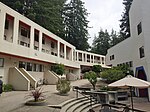The Cowell Lime Works, in Santa Cruz, California, was a manufacturing complex that quarried limestone, produced lime and other limestone products, and manufactured wood barrels for transporting the finished lime. Part of its area is preserved as the Cowell Lime Works Historic District, which was listed on the National Register of Historic Places in 2007. In addition to the four lime kilns, cooperage and other features relating to lime manufacture, the Historic District also includes other structures associated with the Cowell Ranch, including barns, a blacksmith shop, ranch house, cook house and workers' cabins. The 32-acre (130,000 m2) Historic District is located within the University of California, Santa Cruz campus, to either side of the main campus entrance.
The site gets its name from the Cowell family, which owned and operated the lime works, quarries, ranch and large tracts of surrounding timber lands. Industrialist Henry Cowell acquired the ranch and the lime works in the late 19th century. He and his descendants remained owners of the ranch until the death of S. H. (Harry) Cowell, youngest of Henry's five children and last surviving member of the family, in 1955. Cowell's vast estate went to the S. H. Cowell Foundation, still in existence today. The Foundation sold part of the ranch property to the University of California for the creation of the new UC Santa Cruz campus, which opened in 1965. Several of the original ranch buildings have been renovated into university offices. The university's Women's Center is hosted at the Cardiff House, formerly the residence of ranch manager George H. Cardiff.The Cowell Lime Works is just one of many former lime-making sites scattered around north-western Santa Cruz County. Other sites featuring old lime kilns and quarries can be seen in the Fall Creek Unit of Henry Cowell Redwoods State Park, Wilder Ranch State Park and Pogonip (a Santa Cruz greenbelt area).









